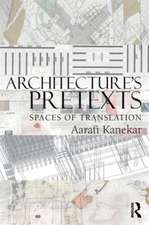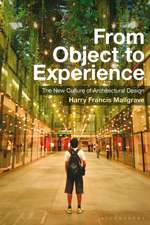Writing Architectures: Ficto-Critical Approaches
Editat de Hélène Frichot, Naomi Steaden Limba Engleză Paperback – 20 apr 2022
| Toate formatele și edițiile | Preț | Express |
|---|---|---|
| Paperback (1) | 172.90 lei 43-57 zile | |
| Bloomsbury Publishing – 20 apr 2022 | 172.90 lei 43-57 zile | |
| Hardback (1) | 601.89 lei 22-36 zile | |
| Bloomsbury Publishing – 28 oct 2020 | 601.89 lei 22-36 zile |
Preț: 172.90 lei
Preț vechi: 214.35 lei
-19% Nou
Puncte Express: 259
Preț estimativ în valută:
33.08€ • 34.64$ • 27.38£
33.08€ • 34.64$ • 27.38£
Carte tipărită la comandă
Livrare economică 07-21 aprilie
Preluare comenzi: 021 569.72.76
Specificații
ISBN-13: 9781350236776
ISBN-10: 1350236772
Pagini: 264
Ilustrații: 35 bw illus
Dimensiuni: 156 x 234 x 17 mm
Greutate: 0.37 kg
Editura: Bloomsbury Publishing
Colecția Bloomsbury Visual Arts
Locul publicării:London, United Kingdom
ISBN-10: 1350236772
Pagini: 264
Ilustrații: 35 bw illus
Dimensiuni: 156 x 234 x 17 mm
Greutate: 0.37 kg
Editura: Bloomsbury Publishing
Colecția Bloomsbury Visual Arts
Locul publicării:London, United Kingdom
Caracteristici
The essays reflect a range of perspectives including feminism and minoritarian positions, acknowledging for instance Australian indigeneity, the post-war context of Japan and post-revolutionary Iran
Notă biografică
Hélène Frichot is Professor of Architecture and Philosophy and Director of the Bachelor of Design at the University of Melbourne, Australia. Naomi Stead is Professor of Architecture and Head of the Department of Architecture at Monash University, Australia and Adjunct Professor in the School of Architecture at the University of Queensland, Australia.
Cuprins
Acknowledgements List of ContributorsList of Illustrations Prelude1. Prelude - the ways in which we write, Jane Rendell (UCL, UK) Writing Architectures2. Waking Ideas From Their Sleep: An introduction to ficto-critical writing in and of architecture, Hélène Frichot (KTH, Sweden) and Naomi Stead (Monash University, Australia)3. From Site to Situation: Cutting up as fictocritical composition, Anna Gibbs (Western Sydney University, Australia)4. Construction (and connection), Katrina Schlunke (University of Tasmania and Sydney, Australia)5. Incompossible Constructions of an Island Paradise, Hélène Frichot (KTH, Sweden)6. Archaeologies of Exile on Trikeri Island: Listening to stones and speculating on prison matters, Elke Krasny and Phoebe Giannisi7. In which Robert Smithson visits Christchurch: Ficto-criticism and the field trip, Jacky Bowring (Lincoln University, New Zealand)8. Hiroshima: Notes of the expanded field, Kim Roberts (Independent Scholar, Australia)9. Writing Walking: Ficto-critical routes through eighteenth-century London, Emma Cheatle (University of Sheffield, UK)10. The Indelible Traces of Your Footsteps, Mireille Roddier (University of Michigan, USA)11. Sydney Letters: A to E, Naomi Stead (Monash University, Australia) and Katrina Schlunke (University of Tasmania and Sydney, Australia)12. Outrage on Calle Alcalá, Scott Colman (Rice University, USA) and Lars Lerup (Rice Univeristy and University of California at Berkeley, USA)13. Architecture as Entourage: The politics of objects, Michael Young (The Cooper Union, USA)14. The Architect Who Couldn't Write, Keith Mitnick (University of Michigan, USA)15. Return to Cold Spring Harbor Laboratory after The Marriage Plot, Sandra Kaji-O'Grady (University of Queensland, Australia)16. The Bannister, Katrina Simon (RMIT University, Australia)17. Nice House, Woodland Lakes, Andrew Steen (University of Tasmania, Australia)18. The Door Left Ajar: On Dissident Waiting and Collective Fiction, Sepideh Karami (University of Edinburgh, UK) Postlude 19. Postlude - Ficto-criticism after critique, Stephen Muecke (Flinders University, Australia) Index
Recenzii
A storybook about architectural storytelling, this important collection conveys well the powers of fiction to get us to things that can often seem more significantly real than the 'facts' as they are officially constituted and received. The authors, while retaining a keen sense of the contingency of their own writing, attend closely to questions of witness, the situatedness of experience and the ways in which the imagination can take flight from them, addressing what stories it matters to tell and the immanent critical charge that they carry.
An extraordinary collection of writings where existential ideas about world orders migrate though different architectural and spatial typologies. Ficto-criticism allows multiplicity, simultaneity and disruption; it allows the reader to travel between different times, places and objects of investigation, enabling multiple connections and complex affinities based on the extrusion of evidence to an event lingering between reality and fiction.
An extraordinary collection of writings where existential ideas about world orders migrate though different architectural and spatial typologies. Ficto-criticism allows multiplicity, simultaneity and disruption; it allows the reader to travel between different times, places and objects of investigation, enabling multiple connections and complex affinities based on the extrusion of evidence to an event lingering between reality and fiction.




















